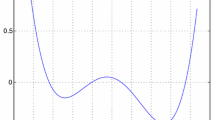Abstract
We examine computational solutions to all of the geometric programming problems published in a recent paper in the Journal of Optimization Theory and Applications. We employed three implementations of published algorithms interchangeably to obtain “perfect duality” for all of these problems. Perfect duality is taken to mean that a computed solution of an optimization problem achieves two properties: (1) primal and dual feasibility and (2) equality of primal and dual objective function values, all within the accuracy of the machine employed. Perfect duality was introduced by Duffin (Math Program 4:125–143,1973). When primal and dual objective values differ, we say there is a duality gap.
Similar content being viewed by others
References
Khanjani Shiraz, R., Tavana, M., Di Caprio, D.: Solving geometric programming problems with normal, linear, zigzag uncertainty distributions. J. Optim. Theory Appl. 170, 243 (2016). doi:10.1007/s10957-015-0857-y.
Duffin, R.J., Peterson, E.L., Zener, C.: Geometric Programming Theory and Applications. Wiley, New York (1967)
Duffin, R.J.: Convex analysis treated by linear programming. Math. Program. 4, 125–143 (1973)
Charnes, A., Cooper, W.W.: Chance constrained programming. Manag. Sci. 5, 73–79 (1959)
Charnes, A., Cooper, W.W.: Deterministic equivalents for optimizing and satisficing under chance constraints. Oper. Res. 11, 18–39 (1963)
Liu, B.: Uncertainty Theory. In The Springer Uncertainty Research Series, 4th edn. Springer, Heidelberg (2015)
Adivar, B. O.: Inventory model with nonlinear cost structure and variable lead time. In: Fourth International Conference on Neural, Parallel & Scientific Computations, Atlanta, Georgia, (2010)
Avriel, M., Wilde, D. J.: Stochastic geometric programming. In: Proceedings of the Princeton Symposium on Mathematical Programming, Princeton university Press, Princeton, New Jersey, pp. 73-91 (1970)
Gribik,P. R.,: Posynomial geometric programming with random coefficients. GSIA, Carnegie Mellon University, (1975). Summer Paper
Jagannathan, R.: A Stochastic geometric programming problem with multiplicative recourse. Oper. Res. Lett. 9, 99–104 (1990)
Mandal, N.K., Roy, T.K., Maiti, M.: Inventory model of deteriorated items with a constraint: a geometric programming approach. Eur. J. Oper. Res. 173, 199–210 (2006)
Smeers, Y., Tyteca, D.: A geometric programming model for the optimal design of waste-water treatment plants. Oper. Res. 32(2), 314–342 (1984)
Creese, R. C.: Geometric Programming for Design Equation Development and Cost/Profit Optimization (with illustrative case study problems and solutions). In: The Synthesis Lectures on Engineering Series, Third Edition, Morgan and Claypool Publishers, (2017)
Rajgopal, J., Bricker, D.L.: Posynomial geometric programming as a special case of semi-infinite linear programming. J. Optim. Theory Appl. 66, 455–475 (1990)
Kortanek, K.O., No, Hoon: A second order affine scaling algorithm for the geometric programming dual with logarithmic barrier. Optimization 23, 303–322 (1992)
Kortanek, K. O., Xu, X., Ye, Y: An infeasible interior–point method for solving primal and dual geometric programs. In: Mathematical Programming, Series B on Interior Point Methods in Theory and Practice, pp. 155–181, (1996). Kurt Anstreicher, Guest Editor
Author information
Authors and Affiliations
Corresponding author
Rights and permissions
About this article
Cite this article
Bricker, D.L., Kortanek, K.O. Perfect Duality in Solving Geometric Programming Problems Under Uncertainty. J Optim Theory Appl 173, 1055–1065 (2017). https://doi.org/10.1007/s10957-017-1097-0
Received:
Accepted:
Published:
Issue Date:
DOI: https://doi.org/10.1007/s10957-017-1097-0
Keywords
- Chance-constrained optimization
- Geometric programming
- Inventory management
- Cost/profit optimization
- Perfect duality




